Cuts of Vegetables: Types and Their Names
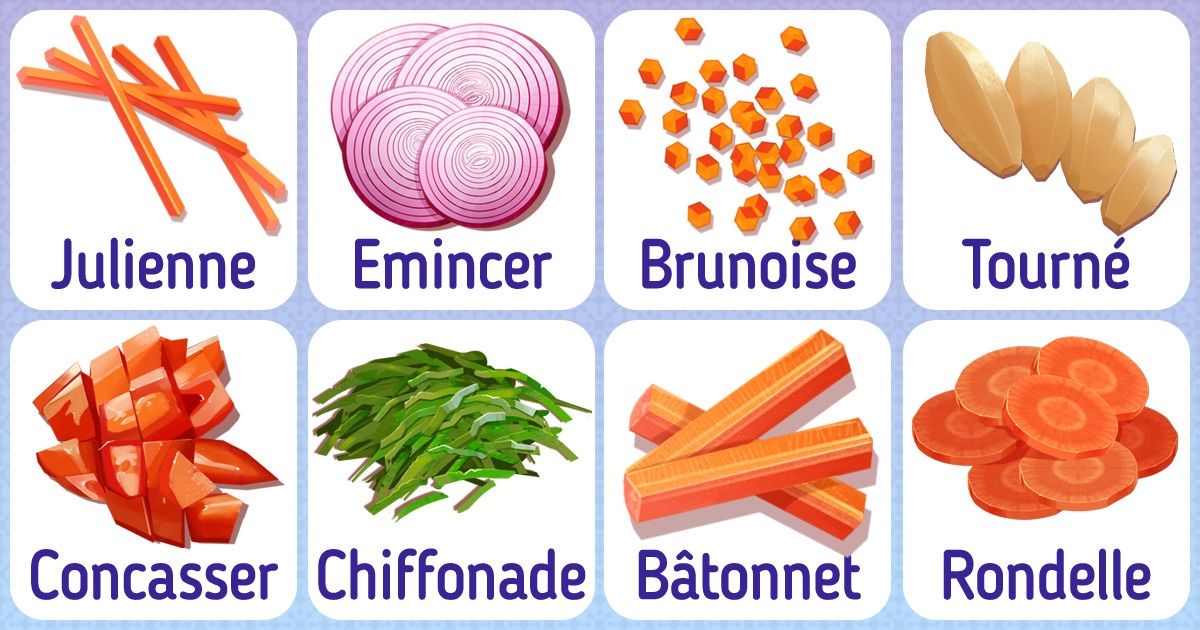
Different ways of cutting vegetables can make your daily cooking way easier. Aside from the basic cuts, there are some that are used for decorating meals and making them appear even more delicious.
In this article, we will tell you about different types of cuts for vegetables. Among them, you are sure to find what you need to create beautiful dishes.
Basic cuts
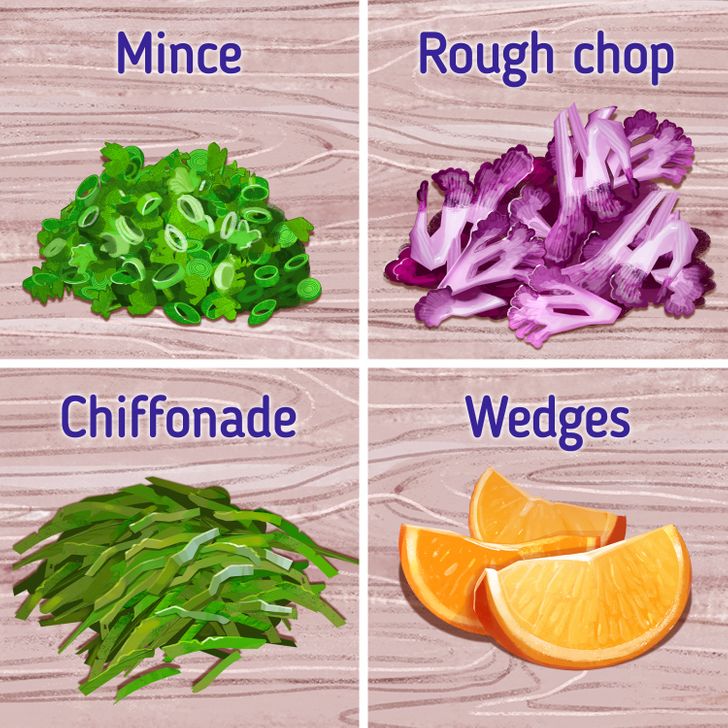
- Mincing is considered very fine cutting. It’s good for garlic and other aromatics. It’s great when we want the flavor to be distributed more throughout the dish.
- Chopping is cutting into a dice without trying to get the same shape. It can be small and rough: the former is great for parsley, and the latter is better for something that isn’t necessarily visible on the plate — it’s more for making the broth tastier.
- Chiffonade is cutting vegetable leaves into long, thin, fine strips, shreds, or ribbons, or just shredding the leaves. To do a chiffonade, gather the leaves into a stack or roll them, then slice them lengthwise into strips. Herb leaves which are thin or irregular in shape, such as thyme, rosemary, parsley, etc., are unsuited for this technique. The technique can also be used on thin crêpes or omelets, or even thin flatbreads, such as flour tortillas.
- Wedges are when you cut fruits and vegetables into segments. First, cut off the ends, and then cut them in the middle and make the wedges.
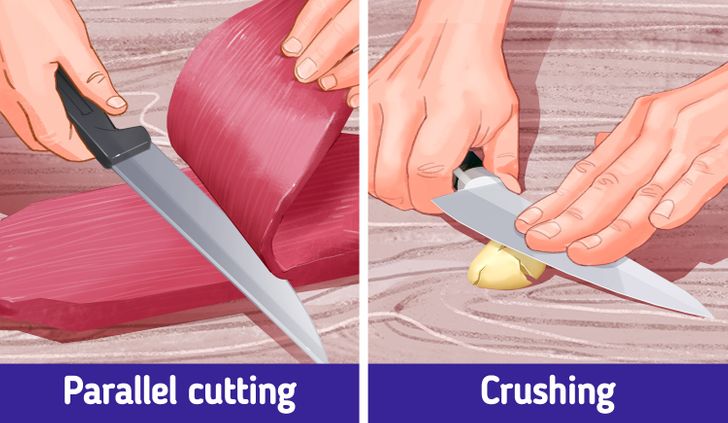
- Parallel cutting is used to cut broad, thin slices of vegetables and meat. You accomplish this by laying your food flat on a cutting surface and angling your knife blade parallel to the cutting surface in order to cut through the food.
- Crushing is done with a knife. It’s good for garlic and ginger. You need a knife with a wide blade you can press garlic with.
Matchsticks
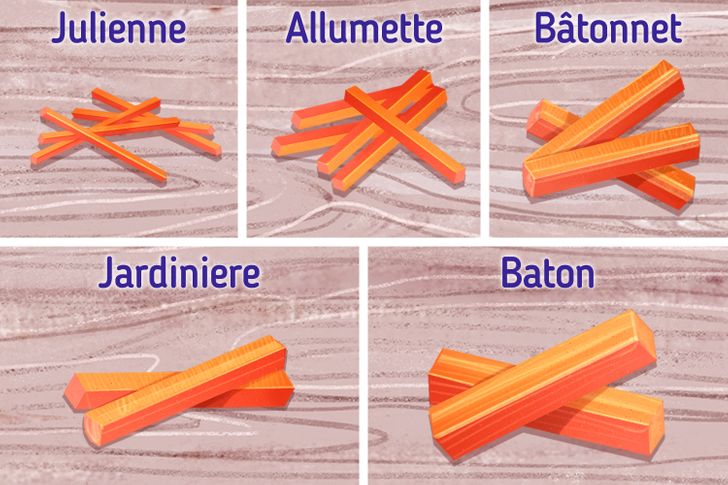
- Julienne is considered small matchsticks. Make a small rectangle and then make matchsticks. The size is 1.5 mm x 1.5 mm square and 5 cm long.
Notice: Some chefs call the above measurements a “fine julienne,” and define a “regular julienne” as being 3 mm x 3mm. Most, though, reserve that 3 mm x 3 mm dimension for the term, “allumette.”
- Allumette is small matchsticks. In French, it means a match. The size is a width of 3×3 mm and a length of 5 cm. The technique is used on solid vegetables, such as potatoes, celery, carrots, pepper, and more.
- Bâtonnet is batons or sticks. Peel and wash the vegetable, then regularize its shape into a rectangle or square by topping and tailing it and squaring off the sides. Then cut it into 6 cm long pieces, then cut each of those pieces into 6mm thick slices.
- Jardiniere is a thicker version of the julienne cut, where sizes range from 2cm x 4mm x 4mm to sizes of 4cm x 10mm x 10mm. They can be used to add a little bit of body to soup or a stir fry dish, or they can even be served as a vegetable side dish.
- Baton is the largest stick cut. It isn’t a commonly used cut, but it can be used for crudites and vegetable sides. The size is 13×13 mm, and the length is 5 cm to 8 cm.
Cubes
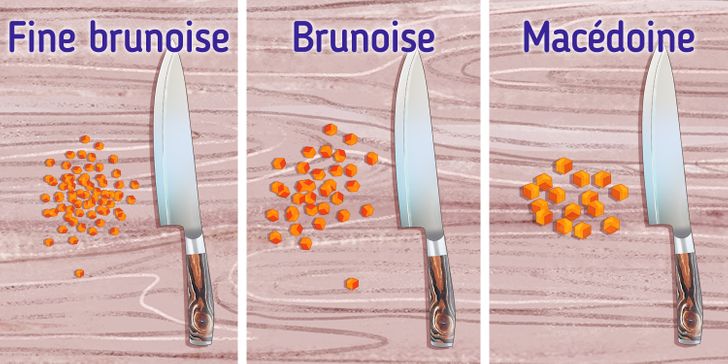
In general, cubes can be different sizes:
- Big — 20 mm
- Medium — 13 mm
- Small — 6 mm
The additional cube types are:
- Fine brunoise — the cubes are 1.5 mm long. In France, this is the most popular option.
- Brunoise — the cubes are 3 mm long, usually used for vegetables such as carrots, celery, onions, potatoes, and tomatoes.
- Macédoine — the cubes are considered medium size at 4 mm long.
Other cuts
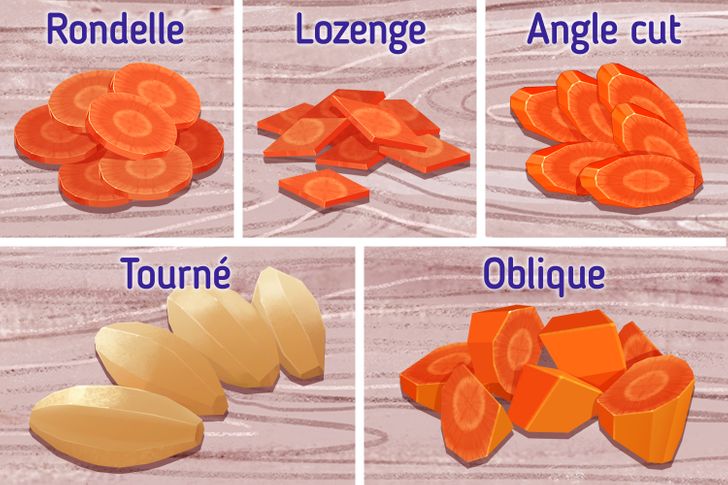
- Rondelle is cutting in circles. There’s no certain size because it all depends on the shape of the vegetable. Just make sure the pieces are the same size.
- Lozenge is a diamond-shaped cut.
- Angle cut gives you an oval shape.
- Tourné is when the pieces look like footballs. First, cut off the ends of the vegetable, then make 7 sides. You can use a peeling knife.
- Oblique is a roll-cut. It’s great to use on carrots. Tilt the knife at 45 degrees and make a cut. Then roll the vegetable and make another cut.
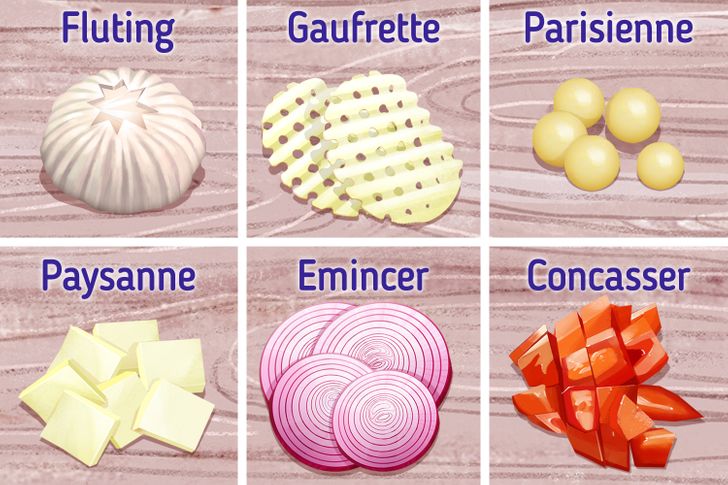
- Fluting is a decorative cut that’s great for mushrooms.
- Gaufrette is waffle cuts. Use the mandoline cutter to do this. First, make one move, then rotate the vegetable 90 degrees and repeat.
- Parisienne is a round ball cut. For this, you need the parisienne scoop. The shape reminds us of an ice cream scoop.
- Paysanne means “country style,” indicating that this is a rougher, more informal cut than other more precise cuts that exist in French cooking.
- Emincer is very thin slices, usually used for onion.
- Concasser is a rough cut for vegetables and fruit and can be big or small.
Bonus: useful tips for cutting fruits and vegetables
- Make sure your cutting board won’t slip while you cut a fruit or vegetable. If your cutting board doesn’t have any rubber parts that will prevent it from sliding, place a rubber mat or a damp towel underneath it before you cut any pieces of food.
- Use the claw grip to protect your fingers and prevent accidents while you cut. Simply make a claw with your non-dominant hand and press your fingertips against the food you’re going to cut. As the fruit or vegetable becomes smaller, curl your fingertips under your hand.
- Stabilize your food on the cutting board by placing the cut side down before you start cutting. This will prevent slips and accidents.
- Make sure your knives are sharp enough. Although this may sound contradictory, a sharp knife is less dangerous than a dull one because the latter requires more pressure while you cut, which can lead to slips.
Check out all these tips and tricks for fridge organization and restocking
Please note: This article was updated in November 2022 to correct source material and factual inaccuracies.
Share This Article